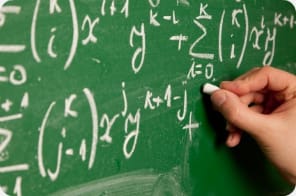Math Teaching Certification

Teachers and theorists often see math as the universal language, transcending cultural and regional barriers. But this universal language does not come naturally for many people.
Certified math teachers are the most prepared individuals to teach the nation’s high-school students math skills that will carry them through the rest of their educational and professional lives. Mathematics fosters problem-solving skills in students, and gives them the tools necessary to make sense of complex issues.
On This Page…
| Why is certification important? |
| Topics in mathematics |
| Obtaining certification |
| Improving mathematical learning |
| Find Schools offering teaching certification programs |
But in order to teach these topics to students, potential math teachers need to show they understand difficult math topics, as well as methods of teaching these topics to students.
Why is certification important?
Certification is a rigorous and demanding process that shows individuals have what it takes to teach.
The math teacher certification process tests potential teachers on their content and pedagogical knowledge of math topics like algebra, geometry, trigonometry, and other subjects.
The certification process is different in each state, but most states require potential teachers to pass tests that show that their hard work in teacher preparation classes equipped them for careers in teaching. For more information on the certification process, click on your state from the map of state teaching certification requirements.
To obtain certification, math teachers need to show they have knowledge of many mathematical topics they will teach students. So what exactly are these topics?
Topics in mathematics
Potential teachers preparing to undergo the certification process should spend the majority of their time reviewing the major math concepts and principles. Without a thorough understanding of these principles, these potential teachers will be unprepared to teach more advanced, college-preparatory classes to high school students.
Algebra and numbers
In order to pass certification assessments, teachers must show an understanding of algebra. This includes knowledge of natural numbers, integers, rational numbers, real numbers, and an ability to perform the basic operations that comprise math problems.
For students who aren’t especially math-centric, the subject sometimes feels like too much of a challenge, to the point where they nearly give up.
Click here to read more about Improving Mathematical Learning…
Potential teachers must compare and contrast the properties of these operations, and know how multiplication, division, addition, and subtraction are interrelated.
Math teachers understand that these basic operations are the foundations of more advanced math topics, and show their students how the topics they learn at the beginning of high school transfer to later grades, and more advanced math classes.
Certification also tests future educators on their knowledge of the properties of prime numbers, even and odd numbers, and multiples. They should be able to express these numbers using algebraic expressions, formulas, and equations to demonstrate an understanding of number theory.
In addition to reaching solutions to math equations and problems, teachers must also present the ability to graph and measure these number systems, especially in regard to geometry.
Geometry and Trigonometry
Potential teachers who want to pass certification must be able to analyze precision, accuracy, and errors in measurement situations. For example, when solving problems between relationships in geometric shapes, teachers must understand concepts of approximation.
They understand that the underlying theme of geometric measurement is fixing a unit of measurement, and then using that unit to measure another geometric figure. This is true in all cases for length, area, or volume.
The certification process necessitates teachers understand basic transformations, such as the reflections, translations, and rotations that underlie concepts of geometry. Teachers must have an understanding of the basic geometric constructions, such as cubes, rectangles, rhombuses, and trapezoids.
Future math teachers must also show an understanding of trigonometric functions that help them plot geometric angles. This includes knowledge of how the cosine and sine of angles reflect in the x and y coordinates on a circle.
They must also exhibit a thorough understanding of the Pythagorean theorem and its applications in trigonometry.
Statistics and Calculus
High school math teachers must prove they know the process of collecting, analyzing, and representing data through statistical methods.
Statistics knowledge allows math teachers to interpret and draw conclusions from data sets, and use these conclusions to reach decisions in complex problems. Teachers who pass certification tests demonstrate how finding the mode, median, and mean contribute to statistical reasoning.
Teachers must also understand statistical limits, such as false generalizations about populations. Teachers organize the statistical data they interpret into algebraic functions and formulas, necessitating a thorough understanding of more complex math topics, such as calculus.
Calculus focuses on functions, limits, integrals, and derivatives. Potential teachers must prove they know how to compute the area between two curves and two vertical lines, proving their understanding of calculus functions.
Calculus provides the basis and proof for many math theories, so teachers must demonstrate how to prove theorems like the existence of maxima and minima for functions on closed intervals.
Obtaining certification
Certification in mathematics shows that a teacher has worked hard to meet the standards set by state certification exams. If you’re interested in a career in teaching high school math, you can learn more about your state’s certification process here.
Improving Mathematical Learning
For students who aren’t especially math-centric, the subject sometimes feels like too much of a challenge, to the point where they nearly give up.
But some teachers believe that adjusting instruction by exploring how other cultures teach math might have positive effects in the American classroom.
According to “Five Ideas for 21st Century Math Classrooms,” published in American Secondary Education, studies show that students from many Asian countries excel in math, and that by adopting some of these teaching strategies, American math scores would improve.
In the article, Kenneth W. Gasser notes that U.S. classrooms must shift focus to “problem-based instruction.” Gasser writes that many math teachers might say they already use problem-based instruction, but in reality, most students don’t care that “27 heads and 78 legs in a barn equates to 12 cows and 15 chickens.”
To make math more applicable to their students, teachers should provide questions that are more meaningful to their students’ lives. For example, students who work on problems such as how much gas they can buy with a set amount of money would show a greater understanding of the subject matter.
Using problems that mean more to students enables students to make more connections to past math applications, and transfers these applications to the current problems, encouraging students to actively process information.
Gasser also says that too often, a teacher is leading an uninterested class of students who don’t feel as if they are actively participating in the learning process. Math teachers should allow students to attempt problems without being lectured, leading to greater discovery and student-led solutions.
Teachers should allow students to attempt new problems with the best of their knowledge. This allows students to discover solutions on their own, dynamically solving problems with experience. After students attempt to solve problems, only then should teachers show students the correct steps and the right approach.
This leads to another valuable trait of learning Gasser says is often missing in the U.S. classroom: failure. Gasser notes that failure should be seen as part of life and the learning process. Students must become less apprehensive of failure, and teachers must produce an environment where failure should not be shameful.
Lightening the classroom mood by making failure normal naturally makes the classroom environment less stressful as well. Students who are having more fun and who are less stressed while learning are also more likely to retain complex concepts of math year-to-year.
Further exploration of math teaching methods has the potential to reshape U.S. classrooms. By encouraging this exploration, math teachers would find their students approaching problems with more interest, leading to better grades.







